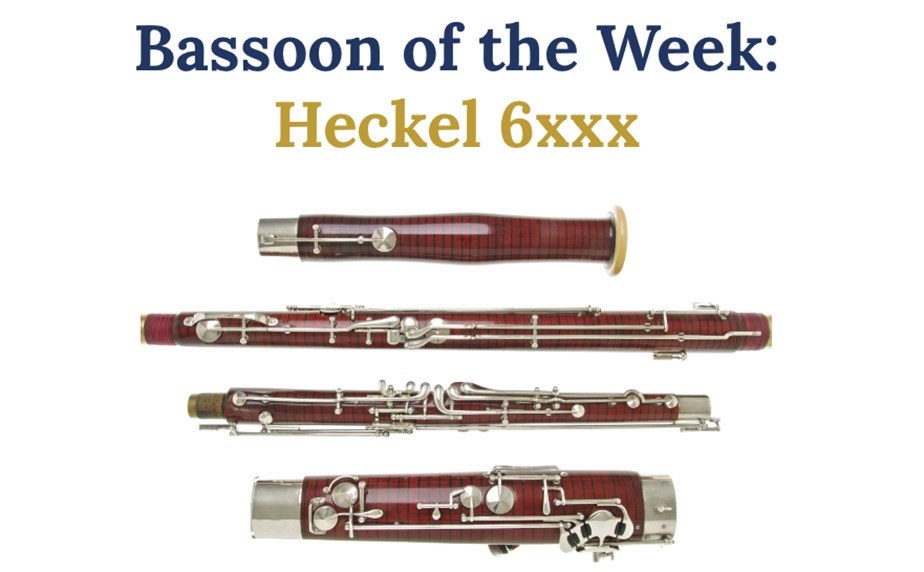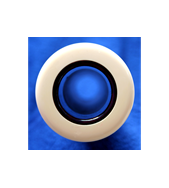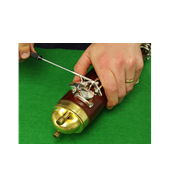Bassoon of the Week: Heckel 6000
October 2nd, 2025

Overview of Heckel bassoons
Heckel pioneered the German-system modern bassoon, on which nearly all of us play, in the middle of the 19th century, and the company has been making premium bassoons ever since.
Heckel has never produced discrete models or model ranges for their bassoons* and so everyone resorts to using the serial number as the method of distinguishing one Heckel bassoon from another. Heckel first started using serial numbers in 1877, a good quarter of a century after they started making bassoons, and started with 3001**. Serial numbers go up incrementally from then on and have now reached beyond 17100.
This doesn’t mean, however, that Heckel has made 14,000 bassoons since 1877 because there are gaps in the serial number list. As well as there being gaps, some serial numbers are completely out of order (14000 is 2004 and not 1996 as 14001 is).
Also, you sometimes see earlier design aspects appearing on later bassoons which had been abandoned some time previously for most other bassoons of that period. For example, the ‘flat-top’ long joint ceased being made in the early 4000s, but appears on occasion up to the 7000s.
In addition, Heckel have always experimented, so a particular feature will appear for a while but then may disappear if it wasn’t deemed a commercial success. They have also always offered a lot of options, so bassoons even with adjacent serial numbers can be quite different.
Bearing the above caveats in mind, broadly speaking Heckel bassoons underwent a steady and incremental development over the decades – from lighter, thinner-walled instruments with more delicate (and slightly fewer) keys and a sweeter tone through to heavier, thicker-walled bassoons with more power and projection. Where your preferences lie on that trend will depend on a combination of your tonal preferences and the intended use to which you will put your bassoon. And on the particular example you pick up to play, as no two instruments are the same.
Serial numbers by year:
3000 – 1852
4000 – 1897
5000 – 1911
6000 – 1923
7000 – 1929
8000 – 1937
9000 – 1943
10000 – 1957
11000 – 1965
12000 – 1975
13000 – 1986
14000 – 1996
15000 – 2003
16000 - 2014
From the early 4000s (broadly speaking, those with a round long joint rather than a flat top), all Heckel bassoons are capable of being played in a modern orchestra. Although the flat top to round top change is easy to spot, the real change in terms of performability was in the tone hole sizes particularly on the boot joint, and particularly the F# and Bb, which were enlarged. This change really opened up the sound, providing more stability and projection.
From the mid-4000s onwards there was a steady and slow evolution towards greater projection and power, so while any Heckel from the 4000s on is easily capable of performing superbly in the large majority of orchestras, for the biggest orchestras/concert halls (e.g. the City of Birmingham Symphony Orchestra in the UK) late models are favoured owing to their thicker-walled design giving greater projection. But if you don’t perform in one of these top world-class orchestras you don’t need to worry – choose one based on your personal preference for tone and your pocket (while no Heckel is cheap second hand, they do become steadily more expensive the younger they are).
The Heckel 6000 for sale
We have sold many dozens of Heckels over the years from 3000 to 15000 series. The Heckel 6000 on sale currently is a fantastic example of a pre-war Heckel, retaining the sweet, resonant tone for which pre-war Heckels are famous, but with enough projection to meet the needs of any serious amateur or professional outside the biggest orchestras.
It was first sold by Heckel in the middle of 1925, making it exactly 100 years old. It first came to us in 2016 from a professional bassoonist in Eastern Europe. At that point it had already been professionally overhauled and modernised in the recent past (with a high E key, for example) to a high standard and was in superb condition. We sold it to the current owner, and as he no longer needs the bassoon he has brought it to us to find another home for it.
It has been carefully maintained over the last nine years and we have given it a full service immediately prior to offering it for sale.
Oliver Ludlow’s thoughts on this bassoon after having played it extensively are:
“This really is a beautiful bassoon – right in the Heckel sweet spot: beautiful tone, great projection, fantastic condition, and fully modernised with all the keywork you could need.”
Of course, if this 6000 is not exactly what you are looking for we do have alternatives. We have an intriguing Heckel 3000 from 1886 available for sale on our historical bassoons page, we have a Heckel 5000 being serviced and coming shortly.
If we have picqued your interest and you would like to try this Heckel 6000 or indeed one of the others please make an appointment to come here where you can have ample time to try it alongside our other professional instruments.
* apart from the Opus/Crest – their only venture into the ‘student’ bassoon market – and a small number of ‘world system’ bassoons, i.e. a French-German-system keywork hybrid. They also made bassoons in pitches other than A=440Hz, but they were not designated models with model numbers, just one option among many they offered (and still offer) to meet customer needs.
**The standard reference work for Heckel instruments, from which the serial number data found here are reproduced, is Wilhelm Heckel, by Edith Rieter, 2014, Wiesbaden






